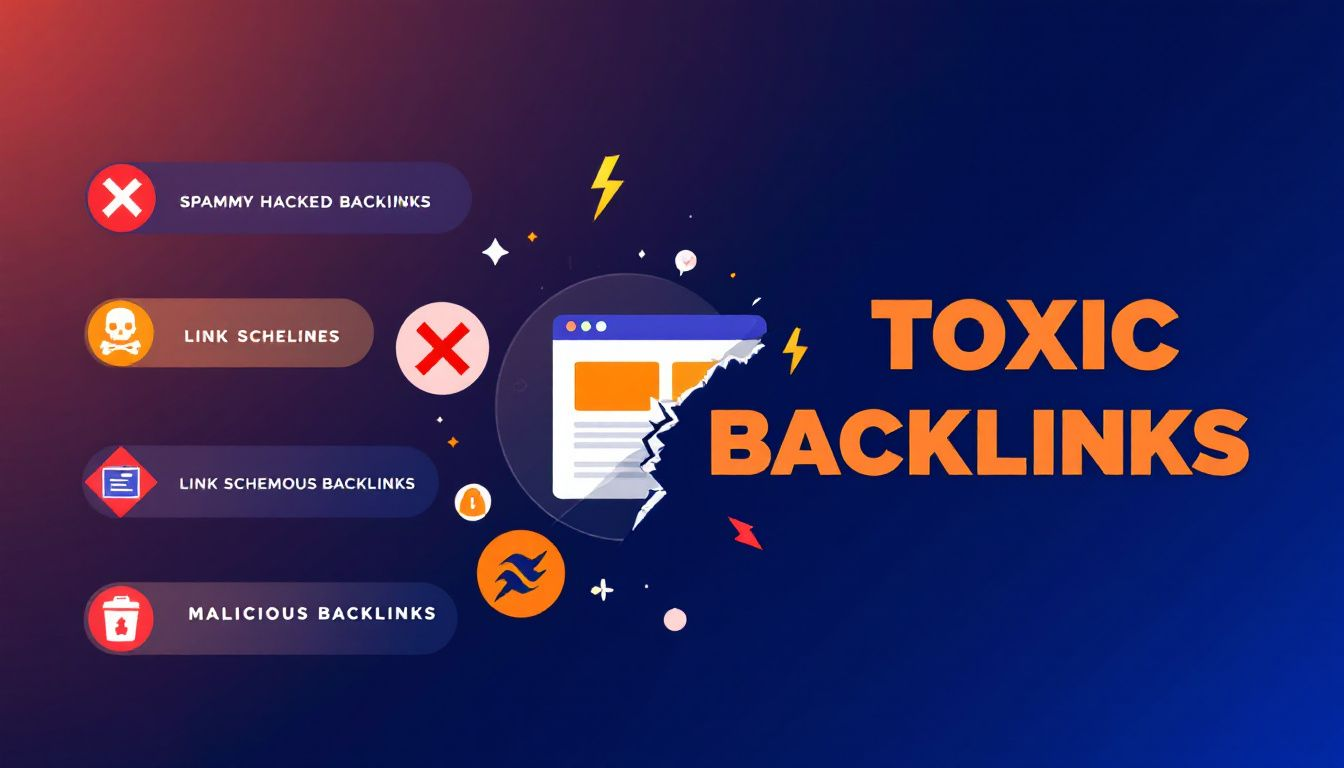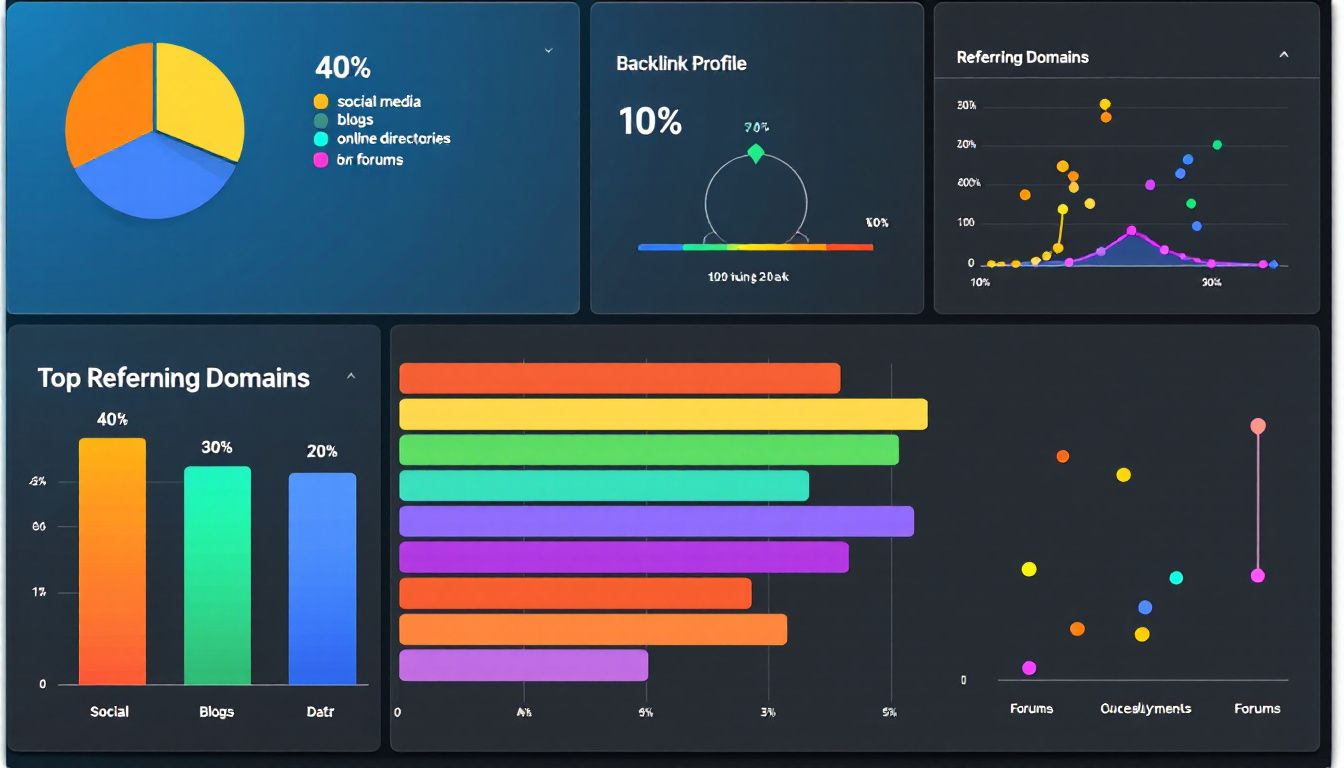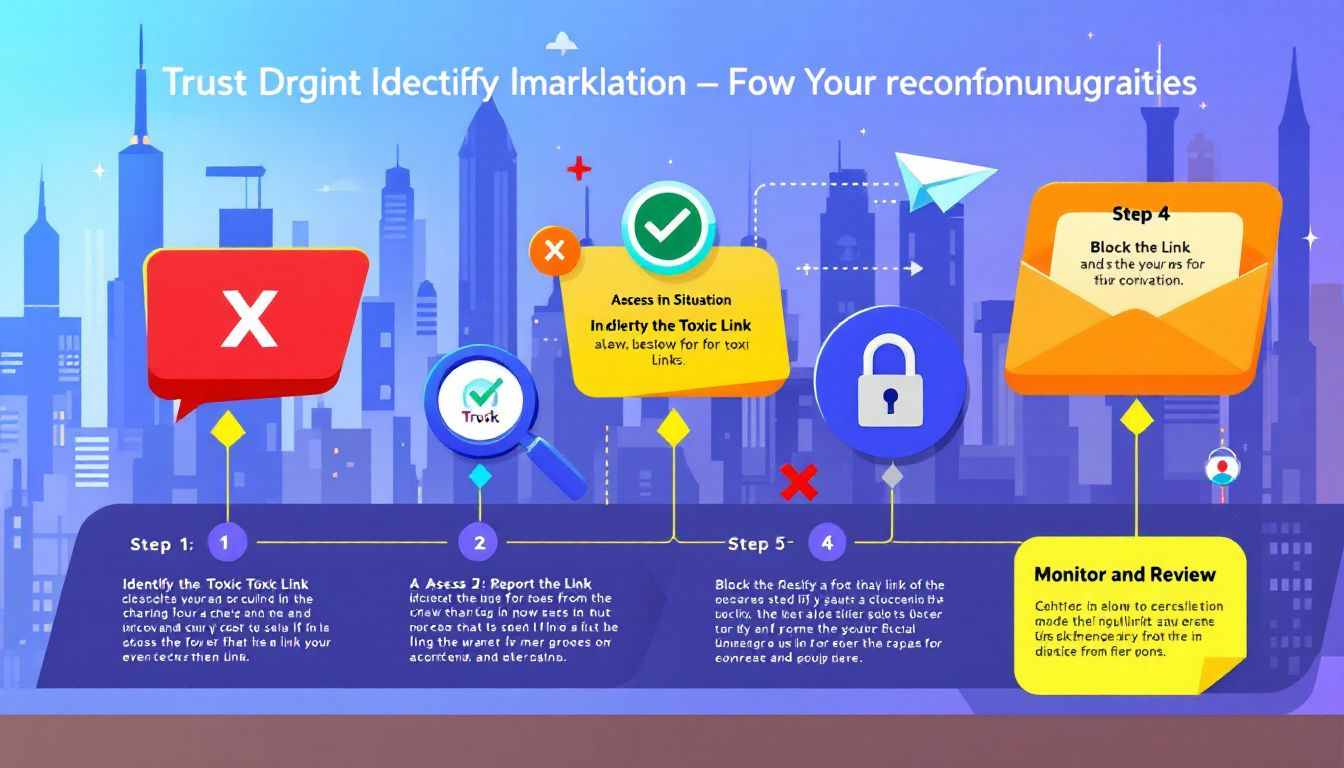Toxic backlinks are harmful links that damage your site’s SEO and violate Google’s guidelines. Knowing what are toxic backlinks helps you protect your site’s ranking. This guide covers identification, management, and removal of these damaging links.
Key Takeaways
- Toxic backlinks negatively impact a website’s SEO and can lead to penalties from search engines; they typically originate from low-authority sites, are irrelevant or spammy, and feature manipulative anchor text.
- Common sources of toxic backlinks include paid links, link exchanges, and private blog networks (PBNs), all of which violate Google’s guidelines and can severely damage a site’s search rankings.
- Regular auditing of a backlink profile using tools like Google Search Console and SEO software is essential for identifying and managing toxic links, with proactive steps such as requesting removals or disavowing links necessary to maintain SEO health.
Defining Toxic Backlinks

Backlinks deemed toxic can detrimentally affect your website’s SEO health and are in direct violation of Google’s webmaster guidelines. These particular links are far from benign, possessing the capacity to degrade both your site’s standing and its good name. Picture a botanical space overrun by pernicious weeds that suffocate flourishing flora. Similarly, toxic backlinks suffocate your online presence, stifling its potential and derailing digital success.
Characteristics that distinguish toxic backlinks include:
- Emergence from websites lacking substantial authority
- Association with content that is either irrelevant or laced with spam
- Connections stemming from non-transparent, user-value-deficient spammy sources
- Utilization of exact match anchor text which raises flags due to their seemingly manipulative intent
Such manipulation in anchor text leads these unnatural links to stand out starkly as unnaturally placed entities adding layers to their harmfulness.
An accumulation of numerous toxic links may serve as evidence of underhanded strategies undermining the confidence search engines might place in your website. In extreme circumstances, such noxious backlinking patterns have the power not only to invoke manual sanctions but also incur formal penalties instituted by Google—a scenario posing serious jeopardy for any website’s SEO endeavors. It becomes imperative then to pinpoint these malevolent connections promptly while proactively curating an untainted and robust backlink profile.
Common Sources of Toxic Backlinks

Understanding the origins of toxic backlinks is crucial for safeguarding your website’s SEO health. Recognizing and addressing the dangers tied to toxic links is an essential initial measure.
Paid Links, Link Exchanges, and Private Blog Networks (PBNs) are recognized as the principal sources of harmful backlinks. Engaging in these practices can breach Google’s webmaster guidelines and may result in serious repercussions for your search engine standings.
Paid Links
Paid links are those that are bought rather than earned naturally. These links are considered harmful because they lack authenticity and credibility, violating Google’s guidelines and manipulating search rankings. If sponsored links do not have the correct attributes, they become toxic links that could harm your site’s search rankings.
To comply with Google’s guidelines, use the nofollow attribute on paid links to prevent them from passing SEO value. Links bought from low-quality sites are often flagged by Google, making the quality of the linking site a critical factor when purchasing links.
Paid links may seem like a quick way to boost your SEO, but they can ultimately lead to penalties and a loss of credibility.
Link Exchanges
Exchanging links, commonly known as reciprocal linking, involves two websites agreeing to link back to one another with the intent of boosting their search engine optimization (SEO). While building links in this manner might seem benign, an overabundance of such mutual links may provoke Google into taking action against them. Google deems excessive reciprocal linking as a form of link spam and it could be detrimental to SEO efforts resulting in penalties or diminished search rankings. Participation in schemes like link farms can also significantly damage a website’s reputation.
It is advisable to steer clear of arrangements that are centered around merely swapping links. Such tactics can have adverse effects, leading your website into trouble for engaging in manipulative practices. It’s crucial for the health of your site’s SEO that you foster natural linkage rather than resorting to aggressive strategies focused on link exchanges which could negatively impact your online presence.
Private Blog Networks (PBNs)
Private Blog Networks, or PBNs, consist of multiple websites that are owned by the same entity. They are established specifically to generate backlinks to a designated target website. These networks are designed to manipulate search rankings through controlled links. While PBNs might offer a quick way to build backlinks, they come with significant risks.
Links from PBNs can be of low quality links and may lead to severe penalties from Google. Using PBNs for backlink building can jeopardize your site’s SEO and result in loss of rankings due to low quality spammy links.
Avoid PBNs and focus on building high-quality, natural backlinks to maintain a healthy backlink profile.
How Google Evaluates Backlink Profiles

Search engines, including Google, assess a website’s backlink profile to gauge its trustworthiness and authority, identifying suspect links that might lead to sanctions. The algorithms deployed by these search engines aim to thwart any attempts at gaming the system for elevated search rankings through deceitful linking strategies. Hence, practices like overusing link swaps or implementing Private Blog Networks (PBNs) may result in your website being marked for engaging in manipulative tactics.
SEO tools such as Semrush’s Backlink Audit offer an analysis of your backlink profile by utilizing more than 45 factors to determine whether each backlink is toxic—usually signified with a Toxicity Score exceeding 50—or benign. This thorough process enables the pinpointing and rectification of potentially harmful backlinks before they can negatively impact how well your site performs.
An excessive quantity of toxic backlinks could provoke either manual action from Google or even penalties which effectively suppress or completely eliminate visibility within their search results. To avoid this outcome, it is crucial to routinely carry out a comprehensive audit on one’s array of incoming links and engage in preventative steps aimed at ensuring the integrity of one’s online reputation among other web entities evaluated by major internet browsers.
Identifying Toxic Backlinks

It’s essential to periodically review your backlink profile to spot and rectify any toxic links that could harm your SEO. Ensuring the integrity of your backlink profile involves recognizing detrimental backlinks.
Various approaches can be employed to identify toxic backlinks, which include utilizing Google Search Console, deploying various SEO tools, or performing manual inspections. These strategies provide distinct perspectives and aid in detecting deleterious links requiring attention.
Using Google Search Console
The Google Search Console provides website administrators the ability to track how well their site is doing, with a focus on backlinks, among other metrics. Once you’re in the ‘Links’ section of Google Search Console, it’s possible to review all links pointing to your website and assess their value using the provided relevant metrics.
When undertaking link removal efforts, it’s strategic to start with those that have been identified as most detrimental based on their Toxicity Score. This method ensures prioritization of harmful links for prompt attention.
Regular scrutiny of your backlink profile via Google Search Console can aid in quickly spotting and neutralizing toxic backlinks thus helping safeguard against potential adverse effects they may have on your search rankings.
Utilizing SEO Tools
Tools designed for SEO, such as the Backlink Audit feature from Semrush, are essential when it comes to spotting toxic backlinks that could negatively affect your site’s ranking. This particular tool scrutinizes your website’s backlink profile by pinpointing unsavory links and rating them with a Toxicity Score, where a higher score signals an increased chance of toxicity.
The Healthcheck function for Backlinks provided by this tool also simplifies the task of isolating these detrimental links by facilitating their exportation for disavowal purposes—thus streamlining their removal from your backlink repertoire. In essence, these instruments furnish you with a detailed examination of your backlink landscape, equipping you to effectively discern and mitigate the risks posed by potentially harmful backlinks.
Manual Checks
Undertaking a manual backlink analysis involves scrutinizing each individual link that leads to your site, which is crucial for grasping the nature of your website’s link profile. Utilize Google Search Console to assess sites linking to you and identify signs of substandard quality within these websites. Be particularly vigilant about websites that have established numerous links or those who have recently linked to you.
When evaluating outbound links on these external sites, consider their volume as it can be indicative of potential toxicity. An excessive number could be problematic. If a toxic backlink is found, reach out to the domain responsible for its placement requesting removal or alternatively employ rel=”nofollow” tags to diminish its influence.
In instances where you choose direct contact for link elimination requests, remember your communication should remain succinctly worded and courteous while conveying clarity in what is being asked.
Actions to Take When You Have Toxic Backlinks

Swiftly spotting and eliminating harmful backlinks can markedly enhance your website’s search engine optimization. If you discover toxic backlinks, the primary measures to adopt include: asking for link removals and disavowing links.
Executing these actions allows you to reclaim authority over your site’s backlink profile and maintain a reputable status with search engines.
Requesting Link Removals
Upon pinpointing toxic backlinks, reach out to the domain that hosts them and ask for their removal or choose to disavow those links when required. Initiate communication with site owners hosting toxic links directed at your website. Tailoring your request can improve the odds of achieving a favorable outcome.
In delivering requests for link elimination, be straightforward and succinct regarding your reasons for requesting the eradication of the toxic link. Elaborate on how this specific undesirable backlink is detrimental to your website’s search engine optimization (SEO) performance. Adopting a courteous and professional manner tends to foster a more cooperative response from the site owner in question.
Disavowing Links
Disavowing links entails submitting a request for Google to exclude certain backlinks from consideration. To create a disavow file, one must compile a list of URLs or domains that you want Google to ignore. This is carried out using the Disavow Links tool provided by Google, where you choose your site and upload the created disavow file.
Should your attempts at removing unwanted links fail, proceeding with link disavowment becomes essential. After uploading your compiled list for disavowment, expect Google to process this information within several weeks. The action of disavowing links serves as an instruction for Google not to take those specific backlinks into account, which helps in minimizing any detrimental impacts they might have on your website’s search engine optimization.
While there is no certainty that submission of a disavow file will lead to removal of these backlinks by Google itself, it does clearly communicate that you wish not be associated with them. Engaging in this procedure can aid in safeguarding against damage potentially caused by toxic backlinks and contribute positively towards enhancing SEO results for your website.
Preventing Future Toxic Backlinks
To preserve the integrity of your backlink profile, it’s essential to deter incoming toxic backlinks from affecting it. If these harmful links don’t seem to harm your SEO efforts, you might opt not to take action against them. One should be cautious and steer clear of engaging with link schemes or responding affirmatively to unsolicited outreach emails that claim they can secure high-quality backlinks.
One should adhere to best practices for acquiring quality backlinks by creating top-notch content and establishing connections with credible entities, which can serve as a strategy against attracting toxic ones.
Consistently scrutinizing your array of backlinks through resources such as Google Search Console and various SEO tools is advisable in order maintain an active stance in overseeing your link environment.
Strengthening Your Backlink Profile
Enhancing your website’s authority and boosting its position in search engine results hinge on establishing a robust backlink profile comprised of high-quality links. Attracting authoritative sites to link to you can be accomplished by developing standout ‘Skyscraper’ content that eclipses existing materials within your field. Engaging content types, including ‘Why’ posts, ‘What’ pieces, infographics, and videos tend to draw more backlinks due to their captivating qualities.
Your site’s status as an authoritative resource could be solidified through the publication of thorough Ultimate Guides on specific subjects—this approach often leads to a steady flow of backlinks over time. Employing tactics such as the Moving Man Method allows you to suggest replacing outdated URLs with relevant links from your updated resources when reaching out directly to these websites.
Choosing collaboration with respected sources for link building significantly lowers the chances of integrating toxic backlinks into your profile. Platforms aimed at bridging connections between journalists and bloggers present valuable prospects for securing quality backlinks. Prioritizing excellent optimized content creation is key. It naturally draws in high-quality backlinks, which mitigates dependence on potentially hazardous link-building strategies.
Summary
Understanding and managing toxic backlinks is essential for maintaining a healthy and effective SEO strategy. Toxic backlinks can severely damage your site’s rankings and reputation, but by recognizing their sources, identifying them, and taking appropriate actions, you can protect your site from their harmful effects. Regularly auditing your backlink profile and using tools like Google Search Console and SEO tools are crucial steps in this process.
Preventing future toxic backlinks and strengthening your backlink profile through high-quality content and reputable link-building practices are vital for long-term SEO success. By staying proactive and vigilant, you can ensure that your site remains in good standing with search engines and continues to attract organic traffic.
Frequently Asked Questions
What are toxic backlinks?
Toxic backlinks are harmful incoming links that can reduce a website’s visibility in search engine results due to their violation of Google’s link spam guidelines.
It is essential to monitor and remove such links to maintain a healthy online presence.
What should you do if you are a victim of a negative SEO attack?
If you are a victim of a negative SEO attack, promptly disavow the spammy links to minimize their impact on your website’s ranking.
It is crucial to take proactive measures rather than relying solely on Google’s intervention.
How does Google evaluate a website’s backlink profile?
Google evaluates a website’s backlink profile by analyzing the quality and relevance of the backlinks to assess the site’s authority and trustworthiness.
It is crucial to avoid manipulative link-building practices as they violate Google’s policies.
What can happen if a website has a large number of toxic backlinks?
The accumulation of a substantial quantity of toxic backlinks may severely damage your site’s ranking on search engines and could even result in a manual penalty that either demotes or completely eliminates your website from the search results.
It is imperative to consistently oversee and rectify any detrimental backlinks in order to preserve the integrity and prominence of your site.
What is Google’s stance on links intended to manipulate search rankings?
Google explicitly classifies links obtained primarily to manipulate search rankings as link spam, and their algorithms are designed to nullify the impact of such unnatural links.




